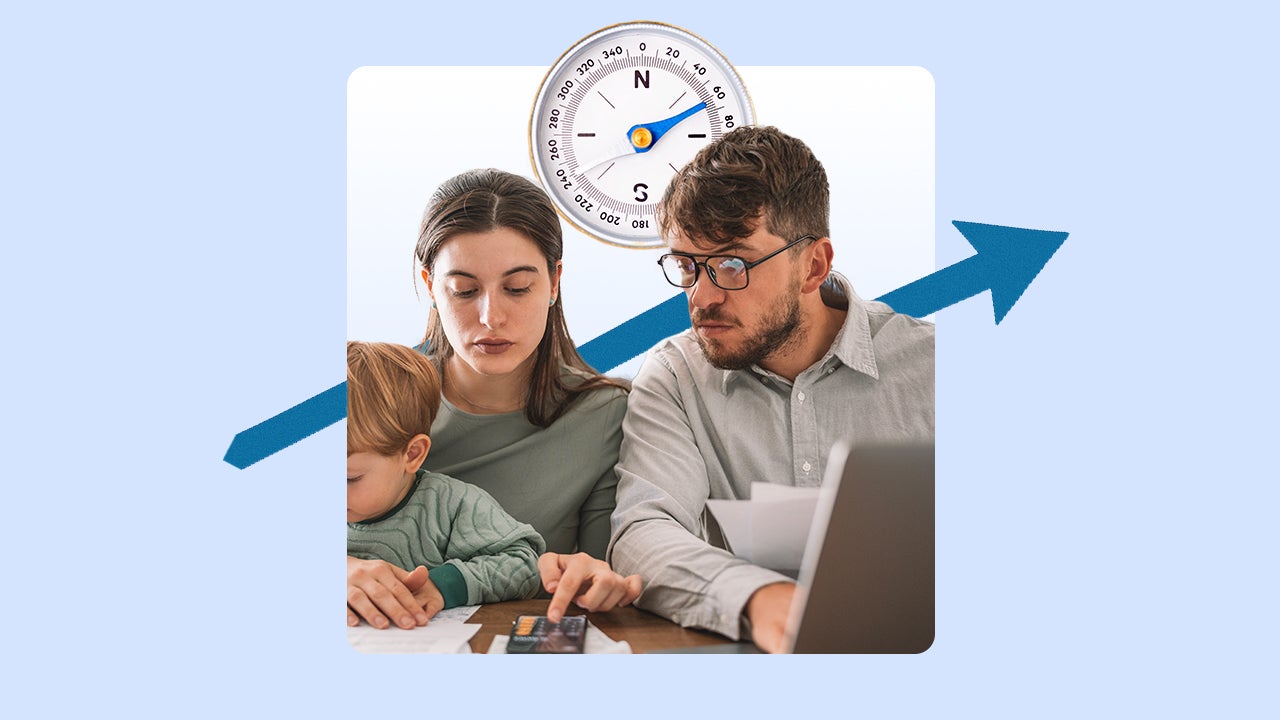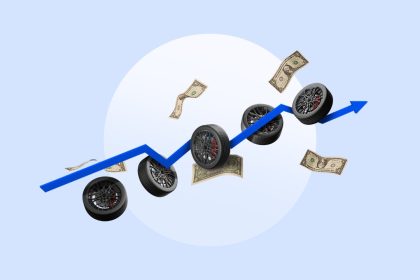Key takeaways
- To combat higher prices due to tariffs, consider shopping secondhand online or seeing what your community offers.
- Avoid panic-buying in reaction to rising prices. Instead, a better move may be to put that money toward your emergency savings.
- Don’t pull the trigger on a major purchase if you can’t afford it, even if you feel compelled to buy it in anticipation of rising prices.
This year, Paige Connell, a 35-year-old in Massachusetts, expects to pay more in child care for her four children than ever before — around $70,000 in total, nearly a quarter of her pre-tax household income.
Adding to that stress, Connell was laid off from her job in apparel last year, during a time when she and other white-collar workers were facing a difficult job market due to slow wage growth and high unemployment. To keep her family afloat, she pivoted and turned her content creation side hustle into a full-time job. The layoff demonstrated how important it was to Connell and her husband that they continuously bring in sufficient income to raise their children.
“(Child care is) always something I’m considering when we think about our employment,” Connell says. “For a lot of families, it limits us in being able to save financially for the future.”
Like many parents, Connell faces the challenge of spending eye-watering amounts for her children’s expenses (including child care), maintaining a lucrative full-time job and still finding room in her budget for other financial goals. The median child care costs for one child alone can be between 8 percent and 19.3 percent of a family’s income, taking into account variation in median family income across U.S. counties, according to 2022 data from the U.S. Department of Labor. And the price of child care doesn’t stop there — as Connell puts it, as her children age out of day care, those costs are simply replaced by after-school care, extracurricular activities and more.
Parents are certainly feeling squeezed, as 31 percent of parents or guardians of children younger than 18 say they’re living paycheck to paycheck on their current salary, according to Bankrate’s June 2024 Living Paycheck to Paycheck Survey. What’s more, only 34 percent of parents (compared to 44 percent of people without children) would pay for a major unexpected expense, such as a $1,000 emergency room visit or car repair, from their savings, according to Bankrate’s Emergency Savings Report. Instead of using savings, the non-ideal alternatives they’d turn to would be financing the expense with a credit card and paying it off over time, taking out a personal loan, borrowing from family or friends or reducing their spending on other things.
Parents are already feeling the pressure, but costs could rise even higher, as the Trump administration’s newest tariff policies could increase the prices of common goods like electronics, apparel and automobiles.
Between high costs and a difficult job market for both private and public sector workers, parents are in a bind. Many will have to find creative solutions to balance their budgets — or risk having their spending spin out of control.
In today’s economic landscape — marked by market volatility, inflation concerns and tenuous job security — financial decisions have never felt more consequential. Our Navigating Now series cuts through the noise with expert guidance and targeted advice for diverse financial situations —whether you’re struggling to build savings amid rising costs, protecting retirement funds during market volatility or securing your income in an uncertain job landscape.
Other articles in the series:
Experts weigh in: Parents will likely see their budgets inflate even more due to tariffs
The Trump administration’s tariffs on imports from countries like China are set to hike up prices significantly for shoes, apparel, toys, motor vehicles and other goods, according to an analysis by Yale University’s Budget Lab. The analysis, which incorporated all tariff announcements from January 1 to April 2, states that American families can expect to pay a little over 18 percent more on leather products (which includes all shoes) and nearly 17 percent more on apparel. Ernie Tedeschi, the director of economics with the Budget Lab, adds that toy prices would go up 18 percent as a result of the tariffs.
These price hikes are coming as Americans — especially lower-income and middle-income families — may already have difficulty paying the rising cost of essential goods.
“When we think about the most disadvantaged families, the reason why tariffs affect them in a disproportionate way is that (their) consumption, especially of basic goods, is a much larger share of their total income (than wealthier families),” says Gustavo Flores-Macias, a professor of government and public policy at Cornell University.
Complicating matters, avoiding raised prices by buying 100 percent domestically-made goods might be harder than many people expect. Dani Morin, a content creator and licensed child safety expert, says that while many baby product companies advertise themselves as 100 percent American-made, that doesn’t mean that their parts are all produced in the U.S. Some products are labeled American-made because they’re assembled in the U.S., even though some or all of their parts are sourced from other countries. With few domestically-made baby products on the market, parents may have no choice but to pay for expensive foreign goods.
‘Navigating Now’: How to manage your budget amid tariffs’ impacts on child expenses
When prices rise outside your control, it can be challenging to manage your budget in reaction. Bankrate talked to four experts in economics and personal finance to share what you and your family can do to mitigate rising prices.
1. Turn to your community
Normally, a straightforward solution for those looking to save money on clothing and cars is to buy from secondhand stores. But tariffs might cause used goods to skyrocket in price, too, according to Tedeschi.
“Just go back to Econ 101,” Tedeschi says. He points to used cars specifically: “If everybody now is responding to higher auto tariffs by looking to used cars as an alternative, the demand for cars is going to go up. And that means higher prices.”
To save on clothing, toys and school supplies, you can still consider buying secondhand through online platforms like Facebook Marketplace or Craigslist, which may offer lower prices than in-person secondhand stores. You can also check social media for Buy Nothing groups, which are neighborhood groups for people to donate or trade their used goods. Additionally, if you have older children or relatives with children, hand-me-downs for clothes and toys will save you a lot of money in the long run.
Keep in mind:
Morin advises that parents avoid Facebook Marketplace or Buy Nothing groups for car seats, cribs and other items that are regulated for safety standards. It’s not always obvious if a car seat or crib is damaged, and sellers aren’t always honest if the product was damaged or involved in a crash. Using damaged products could be a safety risk for your child.
If you need a car seat or crib on a tight budget, check if your county hosts baby item giveaways. Many counties give away car seats and other items to families in need, and Morin says the programs are often underutilized. Additionally, check with your maternal health care provider or local hospital to see if they donate cribs to parents in need.
2. Consider contributing to your emergency savings, rather than panic-buying
Tariffs aren’t a new concept, but the idea of sweeping, sky-high tariffs can be anxiety-inducing. To get ahead of high prices, you may think to stock up on shelf-stable goods like diapers and formula for your family now, but Bankrate Financial Analyst Stephen Kates, CFP, advises against it.
“Don’t let the threat of tariff-induced inflation scare you into hoarding anything and everything,” Kates says. “We are unlikely to see the rate of inflation rise anywhere near what we saw in 2022.”
If you still feel nervous about high prices, Kates advises padding your emergency fund rather than panic-buying. Common personal finance advice recommends keeping three to six months of expenses saved for emergencies. But if you’re concerned about a potential job loss or rising prices, it may be smart to save more than that, such as six months to a year’s worth of expenses.
You should also consider keeping the funds in a high-yield savings account, which can provide a rate of return as high as 4.3 percent, which will help your savings grow over time.
“You can earn a decent return and that cash will be more flexible for your future needs than a pantry full of cans,” Kates says.

Some HYSAs are beating inflation
Many high-yield savings accounts (HYSAs) have interest rates higher than the inflation rate, which is currently 2.3 percent as of April 2025. That’s great news for savers. Bankrate explains how HYSAs can help grow your savings, despite inflation.
Read more
3. Wait until you can afford big-ticket items
Tariffs on essential imported materials like metals and lumber means that big-ticket purchases, such as a home, appliances or automobiles may become more expensive, according to Steven Durlauf, a professor and director of the Stone Center for Research on Wealth Inequality and Mobility at the University of Chicago.
Your instinct might be to rush to purchase that new dishwasher or try to pull together funds for a down payment now, but that would be a mistake, according to experts.
“In environments of radical uncertainty, sometimes it’s good to wait and see,” Durlauf says. “In other words, delay the decision and see how it works out.”
If you have the funds today and you absolutely need a new appliance, you might want to pull the trigger on that purchase before tariffs affect prices. But only pull the trigger on that purchase if you have the funds readily available; don’t go into debt to buy something new.
“If you hadn’t been thinking about a new fridge until you heard costs might go up, then it probably doesn’t make sense to manufacture a reason to upgrade,” Kates says. “Your ability to pay for these items without debt is critical, because high lending rates will cost you more in interest than you’d save by front-running the tariffs.”
4. Look for affordable child care programs or daycare alternatives
Each state has its own financial assistance program for child care as well as services for children with disabilities — you can search for your state on ChildCare.gov and see what programs are available near you. You can also use your state or city site to check if a daycare you’re interested in is licensed or if it’s ever received citations.
If you’re not eligible for local assistance, consider other options like child care co-ops, which are typically in-home or professionally-run cooperatives that care for multiple children at a time; nanny shares, where nannies watch children from multiple households at once; or nonprofit community centers like the YMCA.
Of course, if it’s an option, living near grandparents or other family who can watch your child while you work will always be the most affordable choice for parents. But if that’s not an option for you, programs like child care co-ops and nanny shares could be more affordable options than paying for a day care or nanny on your own. Whatever you choose, make sure the provider is licensed and vetted by other parents.
5. Utilize your local library and community center
Your local library is a great resource for parents looking to save money on books, streaming subscriptions and daytime activities. Most libraries allow you to check out books, DVDs, video games and board games, and many offer activities like story time, craft projects and summer camps to keep your little ones busy all day long.
Additionally, your local community center can be a great resource for athletic programs and summer camps. These programs are typically low-cost or free, and many also offer equally low-cost gym memberships and adult programming for further savings.
6. Embrace DIY and other low-budget activities
Do-it-yourself solutions will also save you money when you’re looking to cut costs. Consider making your own baby food, buying craft supplies in bulk and creating memorable staycations for your kids instead of expensive vacations. Backyard camping, picnics, and local passes for museums, parks and attractions are all great options for parents who want a break from work and school without the cost of an expensive getaway.
The bottom line
The biggest certainty about tariffs is that no one is certain how they will play out. Tariff announcements have come at a rapid — and at times contradictory — clip, making it difficult to make long-term plans now based on the news. If you have the funds readily available, you may want to consider replacing expensive household items, but the safest course of action right now is to protect your savings and budget.
Go over your budget with a fine-toothed comb if you haven’t already, and look for ways to eliminate unnecessary spending, such as unused memberships or subscriptions. Keep a close eye on your spending in the coming months to track which items are rising in price, and look for ways to trim your budget to make room.
If you’re still concerned about rising prices, focus your efforts on increasing your emergency savings. Not only will it give you a higher rate on your return than panic-buying, it will give you peace of mind in an uncertain economic period.

Don’t have a budget yet?
Bankrate’s guide to making a budget will make creating a first-time budget a snap.
Read more
Why we ask for feedback
Your feedback helps us improve our content and services. It takes less than a minute to
complete.
Your responses are anonymous and will only be used for improving our website.
Help us improve our content
Read the full article here




















